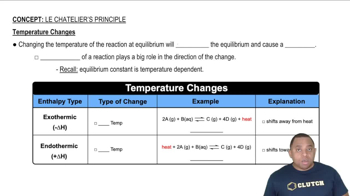Here are the essential concepts you must grasp in order to answer the question correctly.
Le Chatelier's Principle
Le Chatelier's Principle states that if a dynamic equilibrium is disturbed by changing the conditions, the position of equilibrium shifts to counteract the change. In the context of the reaction A(g) ⇌ 2B(g), if we increase the concentration of A or decrease the volume, the equilibrium will shift to the right, favoring the production of B.
Recommended video:
Equilibrium Constant (Kp)
The equilibrium constant (Kp) for a reaction at a given temperature is a measure of the ratio of the partial pressures of the products to the reactants at equilibrium. For the reaction A(g) ⇌ 2B(g), Kp can be expressed as Kp = (P_B^2) / (P_A). Understanding Kp helps predict how changes in pressure or concentration will affect the equilibrium position.
Recommended video:
Equilibrium Constant Expressions
Effect of Temperature on Equilibrium
The effect of temperature on equilibrium is governed by the endothermic or exothermic nature of the reaction. For an exothermic reaction, increasing the temperature shifts the equilibrium to the left, favoring reactants, while decreasing temperature shifts it to the right, favoring products. Knowing the heat of the reaction can guide decisions on temperature adjustments to maximize the yield of B.
Recommended video:
Temperature and Equilibrium Shifts




